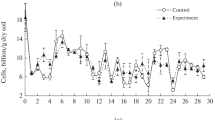Abstract
Viable counts of heterotropic soil bacteria were 3–5 times higher on low-nutrient agar media compared with a series of conventional agar media. Substantial amounts of monosaccharides and amino acids were present in solid media made from distilled water and agar powder, and a salt-solution agar medium (without organic substrates added) gave practically the same colony counts as the low nutrient soil extract agar medium. MPN values were comparable to or lower than plate counts. A search for slow-growing cells in the negative MPN tubes by fluorescence microscopical examination after 3 months incubation was negative.
The viable counts were 2–4% of the total microscopical counts in different soils. Assuming that the colony-forming cells did not derive from the numerous “dwarf” cells present in soil, a calculated percent viability of the larger cells was about 10%. The ecological significance of the plate-counting technique is discussed.
Similar content being viewed by others
References
Amy PS, Monta RY (1983) Starvation-survival patterns of sixteen freshly isolated open-ocean bacteria. Appl Env Microbiol 45:1109–1115
Boyle PJ, Mitchell R (1981) External microflora of a marine wood-boring Isopod. Appl Env Microbiol 42:720–729
Bremner JM (1949) Studies on soil organic matter—I. The chemical nature of soil organic nitrogen. J Agr Res 39:183–193
Buck JD (1974) Effects of medium composition on the recovery of bacteria from sea water. J Exp Mar Biol Ecol 15:25–34
Bunt JS, Rovira AD (1956) Microbiological studies of some subantarctic soils. J Soil Sci 6:119–128
Casida LE (1965) Abundant microorganisms in soil. Appl Microbiol 13:327–334
Casida LE (1977) Small cells in pure cultures ofAgromyces ramosus and in natural soil. Can J Microbiol 23:214–216
Dabek-Szremiawska M, Hattori T (1981) Winogradsky's salts solution as a diluting medium for plate count of oligotrophic bacteria in soil. J Gen Appl Microbiol 27:517–518
Domsch KH, Beck Th, Anderson JPE, Søderstrøm B, Parkinson D, Trolldenier G (1979) A comparison of methods for soil microbial population and biomass studies. Zeitschr Pflanzenernaehr Bodenk 142:552–553
Fægri A, Lid Torsvik V, Goksøyr J (1977) Bacterial and fungal activities in soil: Separation of bacteria and fungi by a rapid fractionated centrifugation technique. Soil Biol Biochem 9:105–112
Fry JC, Zia T (1982) Viability of heterotrophic bacteria in fresh water. J Gen Microbiol 128:2841–2850
Geller A (1983) Growth of bacteria in inorganic medium at different levels of airborne organic substances. Appl Env Microbiol 46:1258–1262
Hattori T (1980) A note on the effect of different types of agar on plate count of oligotrophic bacteria in soil. J Gen Appl Microbiol 26:373–374
Hattori T (1981) Enrichment of oligotrophic bacteria at microsites of soil. J Gen Appl Microbiol 27:43–55
Hobbie JE, Daley RJ, Jasper S (1977) Use of nuclepore filters for counting bacteria by fluorescence microscopy. Appl Env Microbiol 13:1225–1229
Horowitz A, Krichevsky MI, Atlas RM (1983) Characteristics and diversity of subarctic marine oligotrophic, stenoheterotrophic and euryheterotrophic bacterial populations. Can J Microbiol 29:527–535
James N (1958) Soil extract in soil microbiology. Can J Microbiol 4:363–370
Jannasch HW, Jones GE (1959) Bacterial populations in sea water as determined by different methods of enumeration. Limnol Oceanogr 4:128–139
Jensen V (1962) Studies on the microflora of Danish beech forest soils—I. The dilution plate count technique for enumeration of bacteria and fungi in soil. Zbl Bakt Parasitenk II Abt 116:13–32
Kjelleberg S, Humphrey BA, Marshall KC (1983) Initial phases of starvation and activity of bacteria at surfaces. Appl Env Microbiol 46:978–984
Kuznetsov SI, Dubina GA, Lapteva NA (1979) Biology of oligotrophic bacteria. Ann Rev Microbiol 33:377–387
Lochhead AG, Burton MO (1956) Importance of soil extract for the enumeration and study of soil bacteria. Sixieme Congres de la Science du Sol Paris III 157–160
Lund V, Goksøyr J (1980) The effects of water fluctuations on microbial mass and activity in soil. Microb Ecol 6:115–123
Martin JK (1975) Comparison of agar media for counts of viable soil bacteria. Soil Biol Biochem 7:401–402
Mink RW, Patterson JA, Hespell RB (1982) Changes in viability, cell composition and enzyme levels during starvation of continuously cultured (ammonia-limited)Selenomonas ruminantum. Appl Env Microbiol 44:913–922
Morgenlie S (1975) Analysis of mixtures of the common aldoses by gas chromatography-mass-spectrometry of their O-isopropylidene derivatives. Carbohydr Res 41:285–289
Ohta H, Hattori T (1983) Oligotrophic bacteria on organic debris and plant roots in a paddy field soil. Soil Biol Biochem 15:1–8
Parkinson D, Gray TRG, Williams ST (1971) Methods for studying the ecology of soil microorganisms. IBP-Handbook No 19 (Blackwell)
Pochon J (1954) Manuel technique d'analyse microbiologique du Sol. Masson et Cie, Paris
Singh-Verma SB (1968) Zum Problem des quantitativen Nachweis der Mikroflora mit der Metode Koch. Zbl Bakt Parasitenk 122:357–395
Skinner FA, Jones PCT, Mollison JE (1952) A comparison of a direct- and a plate-counting technique for the quantitative estimation of soil microorganisms. J Gen Microbiol 6:261–271
Smith NR, Worden S (1925) Plate counts of soil microorganisms. J Agr Res 31:501–517
Tabor PS, Ohwada K, Colwell RR (1981) Filterable marine bacteria found in the deep sea: Distribution, taxonomy and response to starvation. Microb Ecol 7:67–83
Taylor CB (1936) Short period fluctuations in the numbers of bacterial cells in soil. Proc Royal Soc London Ser B 119:269–295
Torella F, Morita RY (1981) Microcultural study of bacterial size changes and microcolony and ultramicrocolony formation by heterotrophic bacteria in seawater. Appl Env Microbiol 41:518–527
Van Slyke DD, Dillon RT, MacFadyen DA, Hamilton P (1941) Gaseometric determination of carboxyl groups in free amino acids. J Biol Chem 141:627–669
Xu H-S, Roberts N, Singleton FL, Attwell RW, Grimes DJ, Colwell RR (1982) Survival and viability of nonculturableEscherichia coli andVibrio cholerae in estuarine and marine environment. Microb Ecol 8:313–323
Author information
Authors and Affiliations
Rights and permissions
About this article
Cite this article
Olsen, R.A., Bakken, L.R. Viability of soil bacteria: Optimization of plate-counting technique and comparison between total counts and plate counts within different size groups. Microb Ecol 13, 59–74 (1987). https://doi.org/10.1007/BF02014963
Issue Date:
DOI: https://doi.org/10.1007/BF02014963



